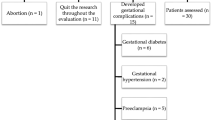Abstract
Objective
To determine the levels of oxidative stress markers in recurrent pregnancy loss using a novel automated method.
Materials and methods
30 pregnant women in their first trimester with a history of recurrent pregnancy loss (RPL) and 30 healthy pregnant women were enrolled in this prospective controlled study. Total antioxidant capacity (TAC), total oxidant level (TOL) and oxidative stress index (OSI) in maternal serum were measured using the more recently designated Erel method.
Results
We observed statistically significant increased TOL and OSI levels in patient group (p = 0.032, p = 0.007, respectively). We also demonstrated statistically significant decreased TAC in pregnant women who had a history of RPL (p = 0.013).
Conclusion
Our results support the concept that oxidative stress plays a central role in the etiopathogenesis of RPL. Further studies to evaluate the predictive role of TAC, TOL, OSI levels using Erel method are needed.



Similar content being viewed by others
References
Wilcox AJ, Weinberg CR, O’Connor JF (1988) Incidence of early loss of pregnancy. N Engl J Med 319:189–194
Gupta S, Agarwal A, Banerjee J, Alvarez JG (2007) The role of oxidative stress in spontaneous abortion and recurrent pregnancy loss: a systematic review. Obstet Gynecol Surv 62:335–347
Halliwell B, Gutteridge JMC (1984) Lipid peroxidation oxygen radicals, cell damage and antioxidant therapy. Lancet 23:1396–1397
Hochstein P, Atallah AS (1988) The nature of oxidant and antioxidant systems in the inhibition of mutation and cancer. J Mut Res. 202:363–375
Erel O (2004) A novel automated method to measure total antioxidant response against potent free radical reactions. J Clin Biochem 37:112–119
Erel O (2005) A new automated colorimetric method for measuring total oxidant status. J Clin Biochem 47:119–129
Ozturk E, Balat O, Acılmıs YG, Ozcan C, Pence S, Erel O (2011) Measurement of the placental total antioxidant status in preeclamptic women using a novel automated method. J Obstet Gynaecol Res. 37:337–342
Burton GJ, Jauniaux E (2004) Placental oxidative stress: from miscarriage to preeclapmsia. J Soc Gynecol Investig 11:342–352
Harma M, Harma M (2006) Defective placentation and resultant oxidative stress play a similar role in complete hydatidiform mole to that in preeclampsia and early pregnancy loss. Med Hypotheses 66:100–102
Poston L, Raijmakers MT (2004) Trophoblast oxidative stress, antioxidants and pregnancy outcome—a review. Placenta 25:72–78
Safronova VG, Matveeva NK, Avkhacheva NV, Sidel’nikova VM, Van’ko LV, Sukhikh GT (2003) Changes in regulation of oxidase activity of peripheral blood granulocytes in women with habitual abortions. Bull Exp Biol Med 136:257–260
Vural P, Akgül C, Yildirim A, Canbaz M (2000) Antioxidant defence in recurrent abortion. Clin Chim Acta 295:169–177
Simşek M, Naziroğlu M, Simşek H, Cay M, Aksakal M, Kumru S (1998) Blood plasma levels of lipoperoxides, glutathione peroxidase, beta carotene, vitamin A and E in women with habitual abortion. Cell Biochem Funct 16:227–231
El-Far M, El-Sayed IH, El-Motwally Ael G, Hashem IA, Bakry N (2007) Tumor necrosis factor-alpha and oxidant status are essential participating factors in unexplained recurrent spontaneous abortions. Clin Chem Lab Med 45:879–880
Schlesier K, Harwat M, Bohm V, Bitsch R (2002) Assessment of antioxidant activity by using different invitro methods. Free Radic Res 36:177–187
Janaszewska A, Bartosz G (2002) Assay of total antioxidant capacity: comparison off our methods as applied to human blood plasma. Scand J Clin Lab Invest 62:231–232
Erel O (2004) A novel automated direct measurement method for total antioxidant capacity using a new generation, more stable ABTS radical cation. Clin Biochem 37(4):277–285
Conflict of interest
None.
Author information
Authors and Affiliations
Corresponding author
Rights and permissions
About this article
Cite this article
Yiyenoğlu, Ö.B., Uğur, M.G., Özcan, H.Ç. et al. Assessment of oxidative stress markers in recurrent pregnancy loss: a prospective study. Arch Gynecol Obstet 289, 1337–1340 (2014). https://doi.org/10.1007/s00404-013-3113-4
Received:
Accepted:
Published:
Issue Date:
DOI: https://doi.org/10.1007/s00404-013-3113-4




